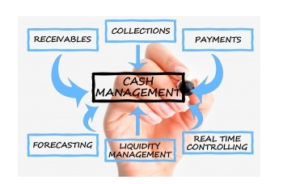Any organisation that experiences growth also experiences operational hurdles. And with companies who have far-reaching subsidiaries, daily cash management challenges become apparent.
In order to keep an organisation functioning, it is ensured that best use of cash or liquid resources is done. A full range of products and services are offered to ensure effective cash management. Banks like ICICI, Bank of India, HDFC, Union bank of India etc. have certain CMS (Cash Management Services) that they offer which helps in satisfying customers. It refers to collecting, concentrating and disbursing cash i.e management of cash balance is done.
Cash management is primarily concerned with cash flows in and out of the system, cash flows within the system and cash balances held by a firm at a time. It facets involve managing, planning and optimizing cash flows and also knowing how to invest surplus cash too.
What Is a Cash Management System?
Cash management is a core service provided by banks to their entire corporate and financial institution client base. The client base starts at the sole trader level, progresses through SME and MME clients, all the way to the largest and most complex of global corporates/financial institutions. All clients of a bank have a need for some part of the bank’s product and service suite in the field of cash management.
In a banking institution, the term Cash Management refers to the day-to-day administration of managing cash inflows and outflows. Because of the multitude of cash transactions on a daily basis, they must be managed.

A cash management system helps to manage cash inflows, outflows and cash flows within a company. It also encompasses the financing of the deficit and the investment of surplus cash to ensure an optimum cash balance. Cash management processes begin when the customer writes cheques to pay the company’s receivable account. The function ends when the supplier, employee, or government receives money from the company on an account payable or accruals. The basic issue of cash management is to allow the company to retain adequate liquidity while at the same time enhance its profitability.
Cash management systems are integrated tools designed to help businesses handle cash processing from end to end. Most cash management programs are created to help from the point of intake to reconciliation. They can streamline the process, which has numerous benefits for businesses. The ultimate goal of cash management is to maximize liquidity and minimize the cost of funds.
Objectives of Cash Management Services(CMS):
- To attract and retain Customers by offering customized products and services.
- To manage cash flows, liquidity and ensure reduction in costs.
- To provide additional value added facilities to customers.
- To adapt the changing business environment.
- To make the process involved in remittances and collection effective and efficient.
- To create niche market segments and stay ahead of competitions.
- Non-customers can also avail this service.
In short, the main objectives of cash management include fulfilling working capital requirements, handling unorganized costs, planning capital expenditure, appropriate utilization of funds, planning capital expenditure, initiating investments, etc. The other objectives of cash management are maximizing liquidity, regulation of cash flows, maximizing the value of available funds, and lowering the costs pertaining to funds.
Benefits of Cash Management:
- Risk reduction
- Collection of funds at the origin’s source
- Faster and easier transfer of money done to any location that is wanted
- Cash management allows estimating the cash profits and not just profits from outstanding incomes and credit sales.
- Nominal fee or commission charged
- Optimum funds management
- Improved liquidity positions of the customers
- Only one account needed even at multiple locations
- Huge Logistics support is offered
- Timely execution of requests
- Timely deposits are done
- Disbursements done at a proper time
- Exposure is monitored
- It helps in detecting cash embezzlement.
- It allows in speeding up the working capital cycle.
- It helps in rewarding such debtors that make quicker payments.
- It speeds up the operations of an organization.
Roles and Functions of Cash Management
The roles and functions are explained below:
- Inventory Management: Cash management helps an organization in managing its inventories. Higher inventory in hand indicates trapped sales, and this further leads to less liquidity. Therefore, a company must always focus on fast pacing its stock out for allowing the movement of cash.
- Receivables Management: A company focuses on raising its invoices so that sales can be boosted. The credit period with respect to receiving cash might range between a minimum of 30 and a maximum of 90 days. This means that the organization has recorded all its sales, but the cash with respect to these transactions has not yet been received. In such a scenario, cash management’s function will ensure that there is a faster recovery of all the receivables to avoid a probable cash crunch. It also includes a follow-up mechanism that ensures there is faster recovery and will also make the company aware of future contingencies like bad debts, etc.
- Payables Management: This is also an important function of cash management where the companies can avail benefits like cash discounts and credit period.
Cash Management Services and its product.

Cash management challenges
Here is a summary of the main challenges:
- Lack of forecasting speed and quality: The practice of cash flow forecasting is contingent on the input of various units across your organization. Some units might be cash managers, financial controllers across different subsidiaries, and many more. The reporting and forecasting accuracy is therefore dependent on that incoming data.
- Redundant system and bank volume: As companies scale and new units spring up globally, system and bank volume tends to continue to increase. Localization can be an issue for a lot of these companies, and they require specific technology that can tend to their needs better than others. This creates a decentralized nature regarding the transparency of data and cash availability.
- Tedious manual and error-prone processes: The physical execution of the individual tasks can lead to entry errors and a lot of time wasted. Consolidating, inputting and checking the validity of data often takes up a large majority of time, leaving scraps of time left to allocate toward strategic endeavors.Two big hamstrings to quick reconciliation are payment processing times and lack of information transmitted with payments. This gets further complicated when cross-border payments and currency fluctuations are introduced.
- Settlements or transactions in multiple currencies: As mentioned, cross-border payments and currency fluctuations further complicate cash management.Cross-border receivables can be costly and complex without proper workflows in place. The top challenges associated with cross-border receivables fall into three broad areas: reconciliation, currency-related complexities and sub-optimal payment terms. Consequently, currency rate fluctuations can negatively affect your profit.
- Regulatory changes: Constantly changing laws, regulations and employment practices can make compliance a difficult to ensure. For example, if your department lacks oversight of cash, counter party risk and existing controls in a high risk jurisdiction, it might be a good idea to think about whether working in that segment will yield any significant value.Fraud, negligence, and lawsuits can spring about when a business is not compliant and there are no internal controls to prevent such things.
Limitations of Cash Management
The limitations are as follows:
- Cash management ignores the accrual concept of accounting
- It is historical in nature; that is; it rearranges the current information which is provided in the profit and loss statement and the balance sheet.
- It is not a substitute for a profit and loss statement.
- It ignores non-cash transactions.
Solutions to cash management challenges
Process restructuring and analysis: Understanding the cash management challenges is only the first piece of the puzzle. Implementing effective solutions to negating challenges is where the value lies. The first step in optimizing any process is analyzing existing systems and workflows to determine where weaknesses lie. There are two recommendations here:
- Holistic cash flow review – Before implementing a structured forecasting workflow, it is important to review historic cash flows. This will provide valuable insights into the nature of existing cash flow movements to help understand where flaws or discrepancies may exist.
- Consistent data analysis and feedback – After implementing your new cash flow structure, thenext step is ensuring you have an automated or scheduled workflow to give users feedback on their data accuracy.Additionally, cash pooling and intercompany netting both play a role in establishing an in-house bank, which is an overarching means of centralizing payments in a group, including Payments and Receivables on Behalf of (POBO/ROBO) or cash pooling, simplified account structures and efficient funding.
The adoption of the cash management system technology across the banking sector
Now that the banking landscape is transitioning to self-service models, banks are investing extensively in banking software that ensures ease of usability, is reliable and fortified with advanced security features. A larger focus is being oriented on the advancement of a cash management system, which includes high volume transfers between various accounts. It is expected that the Digital Transaction Banking market will generate an exponential level of revenues in the coming years. Since smaller banks and enterprises are growing in terms of strength, their increasing asset size is predicting a sharp rise in cash management.
Innovations in cash management systems that expand their industry-wide presence Open Banking/APIs
From the era of proprietary applications, private APIs and close networks, banking has just become increasingly open to technologies such as open APIs, Fintech collaborations, cross-industry partnerships, regulatory changes such as PSD2, etc. These technologies affect all aspects of banking and corporate banking, too, needs to be digitally activated and API ready. Multi-bank cash management, which currently takes hours or days to handle, is set for a major transformation with APIs that will change the way a cash management system operates.
Conclusion
Cash management is a fundamental building block to many other treasury-related responsibilities so ensuring it is executed optimally is imperative. By analyzing structures and implementing the right technology, cash management efficiency and the fast availability of data is at your fingertips.
- CMS is a hybrid system of collections and remittances at faster pace with certain value additions.
- CMS seeks to provide customized and efficient collection and payment services to business entities.
- In other word, it can be said that it is a combination of collection and payment services, customized and packaged to meet the needs of the individuals & businesses.
The cash management system simplifies and automates an enterprise’s finance processes, and provides real-time integration and operations extensibility. It is an essential step to maximize growth and profitability in today’s business environment. Understanding the overall payables/receivables cycle will lead to lower costs, better time efficiencies, increased control, and protection from fraud.
It helps in estimating the cash profits instead of profits earned through credit sales. It can also help in tracing cash embezzlement.
It solves all the problems pertaining to the deficiency in working capital. It also ensures that a company’s solvency is not impacted and the current value of money is more effectively taken into use, along with speeding up the company’s operational activities. However, it must be noted that it is not a substitute for profit and loss statements.
That’s it for now.
Thank you so much for taking the time to read my article! Really appreciate the continued support!
If you have a related query, feel free to let me know in the comments below.
Be part of my FinTech community by subscribing to my blog for more industry content and discussions
Also, share the article with the people who you think might be interested in reading it.
Please leave a comment and share your feedback; it’s what keeps me improving.
Would mean a lot to me and it helps other people see the story.
I look forward to your responses!
Thanks and Regards,
Neha Sahay
![]()




0 Comments